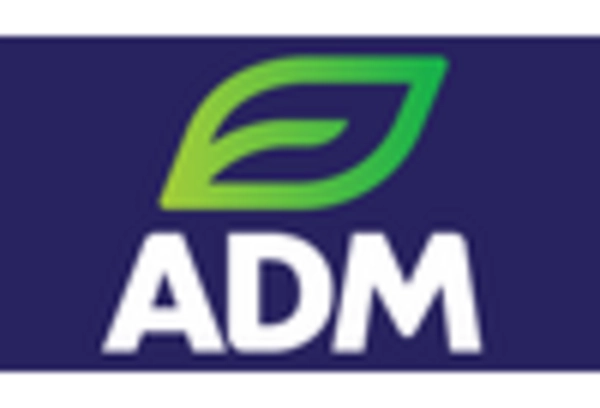Innovation in Food Technology
The Food Bulking Agent Market is witnessing a wave of innovation driven by advancements in food technology. New processing techniques and formulations are enabling the development of novel bulking agents that cater to diverse consumer preferences. For example, the introduction of plant-based bulking agents is gaining popularity as consumers seek alternatives to traditional ingredients. This innovation is not only enhancing the sensory attributes of food products but also addressing dietary restrictions. The market for plant-based food ingredients is projected to expand significantly, with bulking agents playing a crucial role in this transformation. As a result, food manufacturers are increasingly investing in research and development to create innovative bulking solutions that meet evolving consumer demands.
Increasing Demand for Processed Foods
The Food Bulking Agent Market is experiencing a notable surge in demand for processed foods. As consumers increasingly seek convenience, the reliance on processed food products has escalated. This trend is particularly evident in urban areas where busy lifestyles necessitate quick meal solutions. According to recent data, the processed food sector is projected to grow at a compound annual growth rate of approximately 4.5% over the next five years. This growth is likely to drive the demand for food bulking agents, which serve as essential components in enhancing texture, volume, and stability in various food products. Consequently, manufacturers are focusing on incorporating these agents to meet consumer expectations for quality and convenience.
Sustainability and Eco-Friendly Practices
The Food Bulking Agent Market is increasingly shaped by the emphasis on sustainability and eco-friendly practices. Consumers are becoming more discerning about the environmental impact of their food choices, leading to a demand for sustainable ingredients. Bulking agents derived from renewable resources are gaining traction as manufacturers strive to align with eco-conscious consumer preferences. This trend is reflected in the growing market for organic and sustainably sourced food products, which is expected to reach a valuation of several billion dollars in the coming years. Consequently, food companies are prioritizing the use of sustainable bulking agents to enhance their product offerings while minimizing their ecological footprint.
Regulatory Standards and Quality Assurance
The Food Bulking Agent Market is significantly influenced by stringent regulatory standards and quality assurance measures. Governments and regulatory bodies are increasingly implementing guidelines to ensure the safety and quality of food products. This regulatory landscape is compelling manufacturers to adopt high-quality bulking agents that comply with safety standards. As a result, there is a growing emphasis on transparency and traceability in ingredient sourcing. Market data suggests that compliance with these regulations is becoming a competitive advantage for food companies, as consumers are more likely to choose products that adhere to established safety protocols. This trend is likely to drive the demand for reliable and compliant bulking agents in the food industry.
Health Consciousness and Nutritional Awareness
The Food Bulking Agent Market is significantly influenced by the rising health consciousness among consumers. As individuals become more aware of nutritional content and ingredient sourcing, there is a growing preference for food products that offer health benefits. This shift is prompting food manufacturers to utilize bulking agents that not only enhance the physical properties of food but also contribute to nutritional value. For instance, ingredients such as fiber-rich bulking agents are gaining traction as they align with consumer desires for healthier options. Market analysis indicates that the demand for functional food ingredients, including bulking agents, is expected to increase by 6% annually, reflecting a broader trend towards health-oriented food choices.


















Leave a Comment